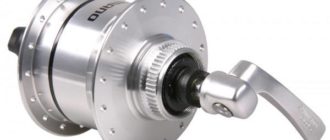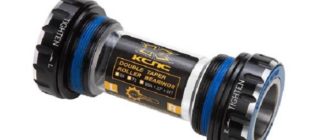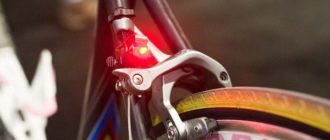Bicyclists are increasingly appearing on public roads. Today, riders can ride not only on pedestrian and bicycle paths, sidewalks, and in parks – bicyclists can also move freely along the roadway with the general flow of traffic.
Consequently, a cyclist must follow certain rules when riding on the roadway, so as not to create an emergency situation. One of the obligatory items in the Traffic Code is the timely and accurate issuance of turn signals. The standard signal of the intended maneuver is an arm outstretched to the right or left side. But recently, bikes equipped with special turn signals have begun to appear on the roads more and more often.
What are bicycle turn signals
The bicycle signal system can act as additional lighting – front and rear lights. The design is a three-section lantern, which is controlled on a special unit attached to the handlebar of the bicycle. The signal lights are attached to the block by wires. The cyclist at a certain moment presses the button – the light starts blinking.
A signal light may consist of the following elements:
- left turn (orange flashing light);
- right turn (flashing yellow light);
- stopper (unblinking bright red light).
The active areas of the lights can be in the form of arrows, indicating the appropriate direction of travel. If rear turn signals are installed, the standard flashlight can act as a parking light. Most often it works in several modes (flashing and one unblinking). When indicating the turn signals, it is better to put the standard lamp in a non-blinking mode, so as not to mislead other road users when turning on the lamp.
Varieties
A typical bicycle signal light unit consists of side turn signals and the central part, which visually separates the light flow from the indicators. There are several types of “flashing lights” for bicycles:
- Signposts located on the vest. In this case, the control panel is located on the handlebar. The indication is only present on the back, so cyclists should also install a front light and rear lights.
- Classic turn signal system with a wired method of switching. In this case, there may be some difficulties with installation. In the store you can find standard lights with LEDs or incandescent bulbs. There are rectangular panels, there are also pointers with a glowing arrow.
- Wireless products. In this case, you will need batteries, signal transmitters and receivers. The device is not well protected against radio frequency interference, so it should be attached to the frame with harnesses.
The distinguishing feature of wireless turn signals is good visibility even in sunny weather.
Pros and cons
When planning to ride on the roadway, cyclists will want to consider how best to alert other road users of their maneuvers. Arm outstretched or all the same bicycle turn signals? At first glance, it seems that the presence of specialized turn signals is the most preferable and safe option. But let’s not jump to conclusions – there are both positive and negative qualities.
For example, in the classical way of the signal by means of an outstretched hand, it is not always possible to keep the steering wheel in the desired position. Especially in the case when the leading hand is down from it. It is not necessary to focus on what the lack of stability on the road can lead to.
With specialized devices, everything is a little easier – it is enough to press a single button to alert other road users of the intended maneuver.
There is another point. By signaling with your hand, the cyclist does so just before the start of the maneuver. The turn signal lights flash for a few moments before the turn and throughout the entire turn (until the driver turns it off).
A significant disadvantage of bicycle turns is insufficient visibility in sunny weather. This is especially true for cheap Chinese models, which can not provide sufficient brightness of the light. At the same time, in cloudy or rainy weather, the raised hand of the cyclist can be invisible to other road users.
Note also that bicycle turn signals can affect the aerodynamic qualities of the bicycle. As you know, any device in suspended form increases the weight of the bike and its aerodynamics and, consequently, its speed.
How to make a turn signal on a bicycle
Significant difficulties in this work will not arise. Basic knowledge in the field of lighting and primitive materials that can be purchased at your local store are enough. For self-assembly you will need:
- Two small flashlights;
- toggle switches;
- wires;
- power cable;
- platform on which the lights will be installed (lightweight plywood or metal plate will do);
- clamps for fasteners.
For self-assembly, we recommend using primitive flashlights with 1-2 modes of operation. Otherwise, there is a great risk of confusion with the connection of wires.
Between the two flashing lights it is advisable to put an ordinary parking light, so that the signal elements do not merge with each other. You need to find the power wire and pull it outside. The USB wire is much more reliable in this regard, because its internal wires can easily be separated into the left and right lights, respectively.
Sequence of further actions:
- Cut the cable on one side and connect it to the lantern lead wires (all wires should be stripped).
- Connect the wires at the other end to the toggle switches, observing the matching sides.
- Attach the lanterns to the platform.
- Attach the assembled construction to the back of the bike (place the toggle switches on the handlebars).
- All fasteners can be done with clamps.
When hanging the wire on the frame, a little slack should be made to prevent excessive tension when turning. A splice can be used to hold the cable securely in place.
The wiring diagram is as follows:
Take into account that the self-assembly of turn signals is not the most reliable measure. For intensive use it is better to buy a better and more durable product.
Conclusion
Turn signals for bicycles – a useful accessory, which is necessary for cyclists riding on the roadway. Devices of such plan allow you to avoid accidents and warn other road users of the intended maneuvers. You can make bicycle turn signals with your own hands, but it is better to buy better quality mechanisms that have several modes of operation.










This is a great post! It’s so informative to learn about how to install bicycle turn signals. It’s definitely useful knowledge for bike riders who want to stay safe and visible on the roads by signaling their turns. Thank you for taking the time to share this important information with us!